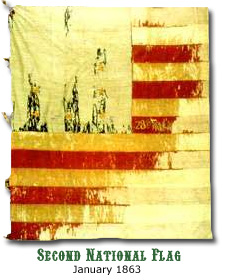Flags
of the 28th Massachusetts (continued)
 hen the
men of the 28th Massachusetts
enlisted in late 1861, they were told they would be joining the Irish
Brigade under the command of Gen. Meagher, a leading Irish patriot.
This promise was belatedly fulfilled in November 1862, when the
regiment joined the brigade's other units — the 63rd, 69th
and 88th New York — in camp near Falmouth, Virginia.
hen the
men of the 28th Massachusetts
enlisted in late 1861, they were told they would be joining the Irish
Brigade under the command of Gen. Meagher, a leading Irish patriot.
This promise was belatedly fulfilled in November 1862, when the
regiment joined the brigade's other units — the 63rd, 69th
and 88th New York — in camp near Falmouth, Virginia.
 Meagher immediately
presented the 28th
with a green flag similar to those carried by his other regiments. Made
by Tiffany & Co. of New York City, it was embroidered entirely
by hand so its lettering appeared backward on the reverse, and was
bounded by a fringe of yellow silk. The flag's stave had silver
furnishings and the lower three feet could be bent upwards by means of
a hinge which under normal use was covered by a plated metal sleeve.
Meagher immediately
presented the 28th
with a green flag similar to those carried by his other regiments. Made
by Tiffany & Co. of New York City, it was embroidered entirely
by hand so its lettering appeared backward on the reverse, and was
bounded by a fringe of yellow silk. The flag's stave had silver
furnishings and the lower three feet could be bent upwards by means of
a hinge which under normal use was covered by a plated metal sleeve.
It appears that Meagher commissioned this
flag at the same time the New York regimental colors were made, since
he understood that a Massachusetts unit would eventually be joining his
brigade. Not knowing what its state designation would be, he had the
flag inscribed simply: "4th Reg't., Irish Brigade."
As fortune would have it, the Irish 28th
Massachusetts was sent first to the Carolinas by Gov. Andrew, who gave
Meagher the non-Irish 29th regiment instead. Meagher had a special
green Tiffany flag made up for his new unit, complete with its
regimental number and state designation, but not being Irish, the 29th
refused it. The beneficiary of this turn of events was the other
Irish-American unit from Boston, the 9th Massachusetts, which served in
the 5th Corps. Meagher simply had the "2" removed from the "29" on the
richly embroidered flag and presented it to his friend, Col. Patrick
Guinee of the 9th.
When the Irish 28th finally replaced the
Yankee 29th a year later, Meagher merely pulled the flag he originally
had made for this unit out of storage, and the 28th Massachusetts was
as well equipped as the other three regiments of the Irish Brigade.
This newly issued Tiffany flag would gain special significance less
than a month later.
Before the Battle of Fredericksburg, Meagher
had sent the tattered and torn green flags of the three New York units
back home so that replacements could be made for them. As the Irish
Brigade was ordered up the hill at Marye's Heights in that legendary
charge, all four of its regiments closed ranks behind the inspiring
green flag of the 28th Massachusetts. Seen by combatants on both sides
as the Irish went up the slope time and again in spite of withering
fire from the rebels at the top, the banner came to symbolize the
sacrifices that Irish-American patriots made so readily for their newly
adopted country.
Extensive battle damage rendered much of the
Tiffany flag unsalvageable when it was turned over to the Commonwealth
of Massachusetts for safekeeping after the war. Today, the surviving
remnants are backed by a replacement green cloth that in no way
duplicates the richness of the original.
 On
December 26, 1862, the 28th sent Capt. Charles Sanborn of Company K
back home to Massachusetts, bearing the battle-torn first national
color and Pilot flag. The state issued the regiment its second national
flag on January 20, 1863. The replacement was larger and more
regulation than the original, with a similar dark blue canton.
Apparently, no new state color was issued, but the city of Boston
provided a replacement green Irish flag.
On
December 26, 1862, the 28th sent Capt. Charles Sanborn of Company K
back home to Massachusetts, bearing the battle-torn first national
color and Pilot flag. The state issued the regiment its second national
flag on January 20, 1863. The replacement was larger and more
regulation than the original, with a similar dark blue canton.
Apparently, no new state color was issued, but the city of Boston
provided a replacement green Irish flag.
When Capt. Sanborn returned to camp in
Virginia with the new flags, future color bearer Peter Welsh remarked
in a letter dated February 15, 1863: "Our captain has got back and
brought a new green flag for the regiment." Although no one knows what
this flag looked like, it probably was nearly identical to the Pilot
flag.
Continued
>

